Roundtable Discussion: Finn Breaks Down the Challenges With Multiple Treatment Options in HCC
Richard S. Finn, MD discusses a 77-year-old White woman who presented with complaints of abdominal pain and fatigue.

During Targeted Oncology Case-Based Roundtable event, Richard S. Finn, MD, professor of Medicine, Division of Hematology/Oncology, director, Signal Transduction and Therapeutics Program at UCLA Jonsson Comprehensive Cancer Center, David Geffen School of Medicine at UCLA, discussed the case of a 77-year-old patient with hepatocellular carcinoma.
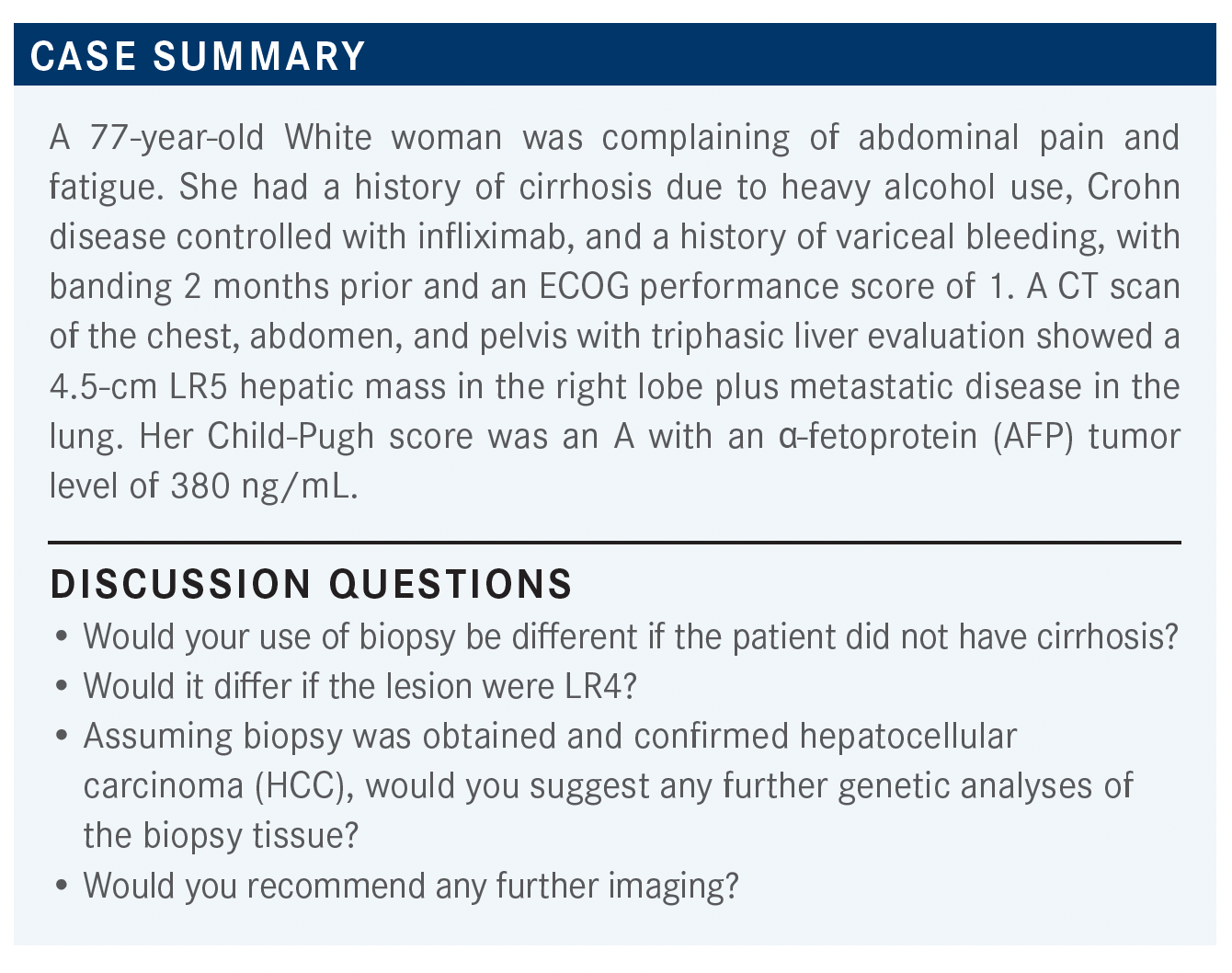
FINN: This patient has cirrhosis and on the CT scan [has a tumor of] 4.5 cm and a LI-RADS [Liver Imaging Reporting and Data System] score of 5 [LR5].
When we see LR5 it means the patient almost definitely has liver cancer and a biopsy is not required. LI-RADS is like Breast Imaging Reporting and Data System [BI-RADS] in mammography. It is how the radiologist assesses the likelihood of something being liver cancer and only applies to patients who have cirrhosis.
If someone does not have cirrhosis, you can’t apply the LI-RADS criteria. On a triple-phase scan, a hypervascular tumor with delayed washout is characteristic of LR5 and you do not technically need a biopsy for management. The AFP of 380 ng/mL is suggestive, but AFP is not among the criteria for making this diagnosis. I would say that this patient does not require a biopsy for standard-of-care treatment.
KARWAL: I would like to add [that] if you look at the data, sensitivity and specificity do not change with adding a biopsy, but you add risk. The biopsy is going to show you a normal liver if they miss, but if it comes as [HCC], it tells you what you already know. You do not gain in sensitivity or specificity in this case by adding a biopsy and it should not be done because you do not add to the data.
FINN: I guess the only reason to do a biopsy would be perhaps in the context of research or some molecular understanding of the tumor, which does not impact standard-of-care treatment.
CHAND: What if the AFP were in the thousands—would you still do a biopsy?
FINN: No…because [the tumor] is LR5.

FINN: If the patient was not cirrhotic, and even with an elevated AFP level, I think you are obligated to do a biopsy. I think very likely it could be liver cancer, but I had a case recently of a patient in his 40s who had cirrhosis and came down for a second opinion and had already been started on treatment for his advanced liver cancer.
They had biopsied him there and said it was liver cancer, but I would not have necessarily done the biopsy based on the imaging. However, he already had a biopsy when he came to see the surgeon, who had our pathologist at the [University of California, Los Angeles] review it and they said it is not exactly consistent with HCC.
When we looked back at the outside imaging, it was not completely vascular and a repeat biopsy was recommended. [The patient’s] AFP was 15,000 to 30,000 and it turns out he had a germ cell tumor. Lucky for him, he got BEP [bleomycin (Blenoxane), etoposide (Toposar), and cisplatin (Platinol)], had a great response, and is going for curative resection.
KARWAL: Did the biopsy show cirrhosis?
FINN: He did have some cirrhotic changes. He had hepatitis C and a little portal hypertension. He did not have a normal biopsy; he just had a biopsy of his tumor.
KARWAL: Didn’t the background liver test results include that?
FINN: There was no background. It was an 18-cm mass. A very bizarre case, especially for a patient with an LR4 lesion; regardless of the AFP, they most likely have liver cancer. In practice, I do not think we would do a biopsy, to be honest. Keep in mind, if you are thinking of liver transplants, at least get another opinion.
This disease is best managed at a tertiary center. To get a liver transplant, you need an LR5 lesion. If it is LR4, which is potentially curable, usually we do not ablate them until they become LR5 if we are thinking curative transplant. In practice, in a patient who is cirrhotic, even if it is LR4, it is most likely liver cancer.
You must ask yourself what you are going to find that is a better diagnosis. Is there any evidence of disease elsewhere? Cholangiocarcinoma does not typically have vascular characteristics like liver cancer. This is still most likely going to be liver cancer.

FINN: This is not lung cancer where we have molecular treatment options based on the tissue. The thing that comes up is NTRK fusions, which are very rare in liver cancer and not something I routinely look for. That is the only thing on a rare course that you would look for, but there are no FDA-approved drugs for liver cancer that require a molecular diagnostic test.
CHAND: What about combined HCC and cholangiocarcinoma?
FINN: It is a real entity that probably reflects a tumor that arises from the same cell of origin and typically those will not be LR5 lesions.
They are usually something that gets biopsied for whatever reason, perhaps post resection, and surprisingly has both components. I have had patients who have a resection and then think they have liver cancer on explant. Then they develop recurrence of a lymph node and we biopsy that to confirm recurrence and it is cholangiocarcinoma.
These are not-so-common tumors and you treat them like cholangiocarcinoma or HCC. Typically, I start with one approach and if they progress I go to the other. Maybe give [gemcitabine (Gemzar) plus cisplatin] and if they are progressing, then atezolizumab [Tecentriq] plus bevacizumab [Avastin] or vice versa.
The other thing you can do with an LR4 lesion would be to get an MRI. If on a CT scan it is LR5, you could get an MRI, which is a little better for imaging the liver, and there is a good chance that it will be LR5 using another technique, but even with an LR4 lesion, it is most likely liver cancer.
When the biopsy is obtained and it confirms HCC— stage IV disease given there is extrahepatic spread, or by the [Barcelona Clinic Liver Cancer] criteria, it would be stage C.
YEH: In what situation would you biopsy HCC again to confirm HCC? Because you said LR4, you might not need it if you get a different image modality. I would also like to know about enrolling [the patient] in a clinical trial. In the community [setting they do not report] LI-RADS, they might not even know what that is. I had to look up what LR4 is, and they usually just say suspicious for cholangiocarcinoma, [which is not as clear].
FINN: I think most radiologists are familiar with LI-RADS. It should be in their training, but whether they use it routinely is something you would have to press them on because if they are not declaring it, then I think you are forced to do a biopsy for these patients, right? Because we are saying the main diagnosis of HCC is based on radiographic and clinical parameters, but that means you depend on your radiologist. It is like having a pathologist do a biopsy and saying suspicious for cancer—what does that mean?
Those needing a biopsy are those with a big tumor that is LR3; they are cirrhotic, but they can’t say it is liver cancer. It is unusual to see that because LI-RADS is related to some degree to the size of the lesion, and obviously it is harder to apply sometimes for smaller lesions vs larger lesions. But the [radiologists] should know that term.
YEH: Is AFP not helpful in diagnosing [HCC in patients]?
FINN: It is not helpful in screening alone because about one-third of liver cancers do not make AFP. When it is high, certainly it is very suggestive, especially in the right clinical context, but it is not an accepted diagnostic criterion by itself without imaging. It is all odds. Most likely an AFP of 3000 is going to be HCC in someone with hepatitis C, but if the imaging is not convincing, then you do a biopsy.
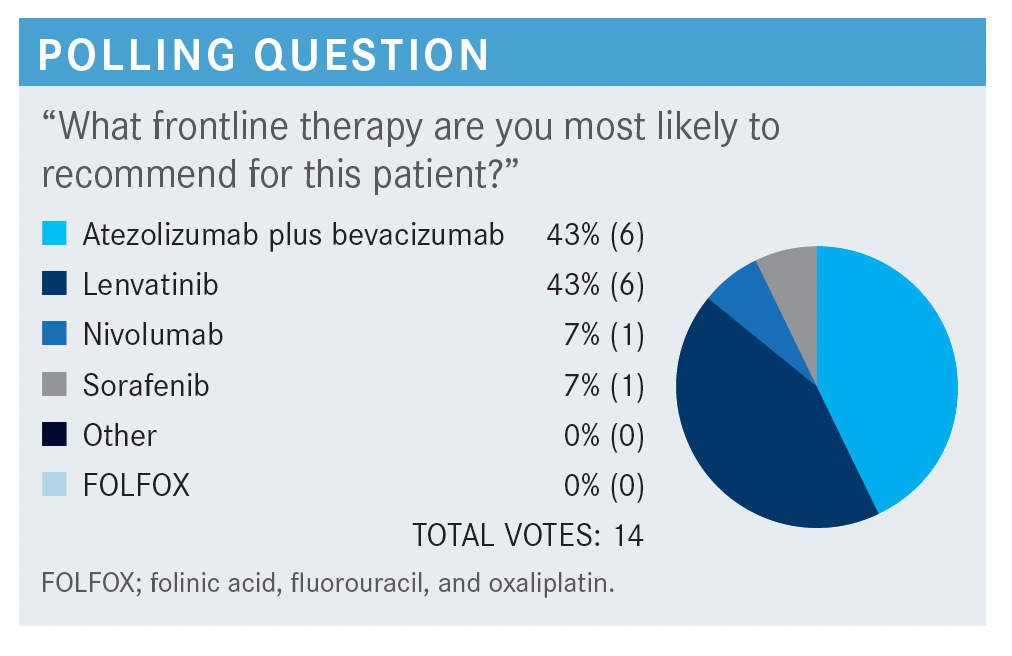
FINN: The caveat in this case is that the patient has Crohn disease and has been treated with infliximab [Remicade].
I think we need to take a pause about using a PD-1 inhibitor [such as nivolumab (Opdivo)] in this patient. Nivolumab’s approval in liver cancer was withdrawn, and it was [formerly] approved as a single-agent second-line therapy like pembrolizumab [Keytruda].1
Lenvatinib [Lenvima] would be a very reasonable option for this patient. It is approved as frontline therapy and is an active drug being compared with sorafenib [Nexavar] in the REFLECT study [NCT01761266] based on noninferiority.2 It has a little higher single-digit overall response rate [ORR] than sorafenib.
The adverse event [AE] profile is a little different. I do not know that I would necessarily go with sorafenib, but at the same time I can’t say that it is wrong. I would want to give this patient atezolizumab plus bevacizumab [Avastin], but I think we have too many contraindications. They also have a history of variceal bleeding and would need an endoscopy as well as the issue with the Crohn disease.
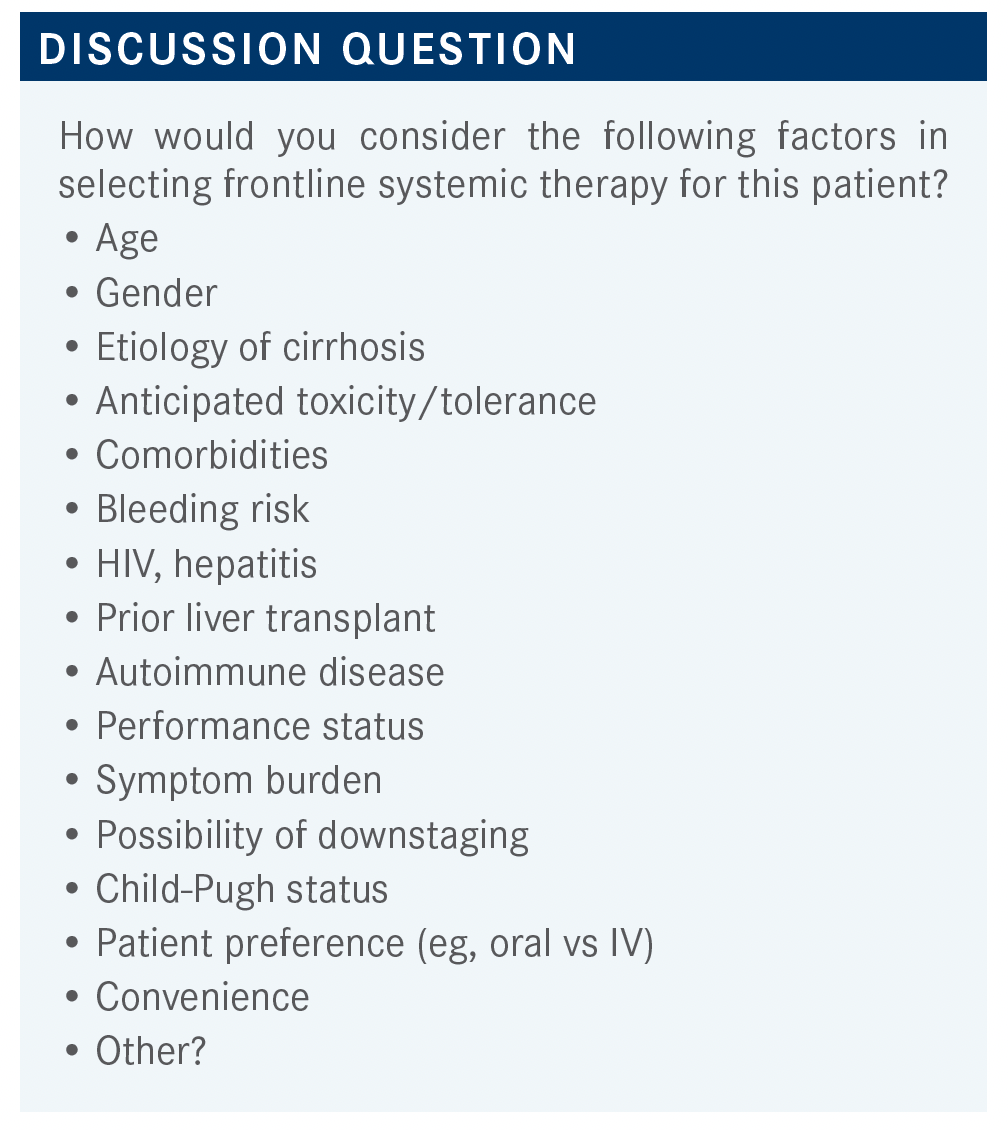
SARKISSIAN: There is a case series for liver and kidney transplants. The liver grafts fail within 1 or 2 weeks, almost every single one. For kidney [transplants], I think you might also get away with it.
FINN: I am at a large liver transplant center, and we have generally shied away from it. I recently gave a patient nivolumab. He was at the very end of his course for everything; we gave him FOLFOX and he is 10 years out from his transplant now. We watched him very closely; he had no toxicity, but no benefit either. I would not recommend this as a standard, frontline approach. These case series show a high risk of liver failure and rejection.
Now, if they have autoimmune disease? Using atezolizumab or any immunotherapy [IO] drug in liver cancer is not different from any other malignancy where these drugs are approved. High risk of autoimmune hepatitis, which was always an initial concern, is something to keep in mind.
PHAM: I think if you are looking for downgrading, you are either relying on atezolizumab plus bevacizumab with an ORR of 30%, or with lenvatinib where [I think it is about] 20%. If you are using an immunotherapy, you are trying to get the patient to transplant. I think this is a tough choice.
FINN: If you want a response, obviously atezolizumab plus bevacizumab has a higher response. About transplant, I think your point about having an IO drug on the board is not what we are doing; that is more likely local-regional treatment. But this idea of neoadjuvant before resection maybe will have patients getting big responses who we would then consider for resection.
CHAND: I just want to verify, if you give someone an IO drug, can they still go to transplant later if you downstage them?
FINN: This is a new realm…and not something that we had to deal with in the past. I do not think we want to see them having an IO within a certain time before they get their liver transplant. I think that is something that [individuals] are trying to figure out.
If they have an IO on board, there has been some discussion about when you stop the IO. Just because they had a dose 1 year ago would probably not preclude them but having it close to transplant has been associated with a higher risk of rejection.
Any other issues that come into mind when you are choosing your first-line therapy that we have not discussed? Patient preference, obviously, will always weigh in. Convenience? Cost? I guess insurance approval will always be [a factor].
KARWAL: You can treat with the atezolizumab plus bevacizumab for this 7-cm tumor and hope to get a response. If it goes to 4 cm, stop the atezolizumab plus bevacizumab then use local-regional therapy, and then get the liver transplant. It is kind of a dream because you do not get there very often, but it is a possibility.
FINN: With atezolizumab plus bevacizumab only being recently approved, it is a new realm of things. Honestly, the other flip side is some of these patients are doing very well and they have had dramatic responses, so do we mess with that? Maybe some of these patients may be cured over time.
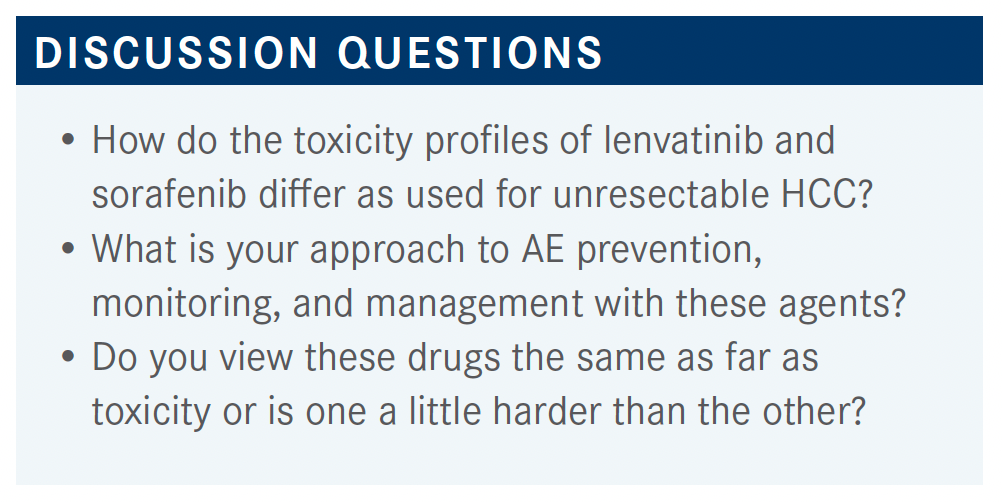
FINN: Hand-foot syndrome [HFS] is more common and more high-grade with sorafenib vs lenvatinib. Diarrhea is the same for both, but maybe slightly higher with sorafenib. Hypertension is more of an issue with lenvatinib, but I think it reflects its potent VEGF inhibition activity. It also causes dysphonia and proteinuria. Appetite loss is similar between the 2, but a little higher with lenvatinib. Weight loss is a little higher with lenvatinib vs sorafenib.2
GREEN: I found lenvatinib to be a little tougher. The weight loss and hypertension are tougher, but I think it is manageable. It just requires keeping a closer eye on the patients. I tend to go more for that because I think it is a more active drug. Aside from the HFS, which is something I have not run into, the weight loss and hypertension are issues that I have made dose adjustments on.
CHANDURI: Lenvatinib used in other tumors like renal cell and endometrial carcinoma is well tolerated. The hypertension is under control and diarrhea is not a big problem. I have not had anybody with HCC, but I think with a little dose adjustment, the hypertension or weight loss can be well managed unless the underlying HCC problems complicate it.
FINN: Hypertension does happen even in patients with liver who tend to run a little low blood pressure to start with. Maybe the hardest thing for these patients is the anorexia and weight loss. There is no quick fix for that. Often, they need a little break or dose reduction from 12 mg to 8 mg or 8 mg to 4 mg, depending on their starting dose.
REFERENCES:
1. NCCN. Clinical Practice Guidelines in Oncology. B-cell lymphomas, version 5.2021. Accessed November 22, 2021. https://bit.ly/3HMAlVP
2. Duell J, Maddocks KJ, González-Barca E, et al. Long-term outcomes from the phase II L-MIND study of tafasitamab (MOR208) plus lenalidomide in patients with relapsed or refractory diffuse large B-cell lymphoma. Haematologica. 2021;106(9):2417-2426. doi:10.3324/haematol.2021.275958
3. Sehn LH, Herrera AF, Flowers CR, et al. Polatuzumab vedotin in relapsed or refractory diffuse large B-cell lymphoma. J Clin Oncol. 2020;38(2):155-165. doi:10.1200/JCO.19.00172
4. Lu T, Gibiansky L, Li X, et al. Exposure-safety and exposure-efficacy analyses of polatuzumab vedotin in patients with relapsed or refractory diffuse large B-cell lymphoma. Leuk Lymphoma. 2020;61(12):2905-2914. doi:10.1080/10428194.2020.1795154
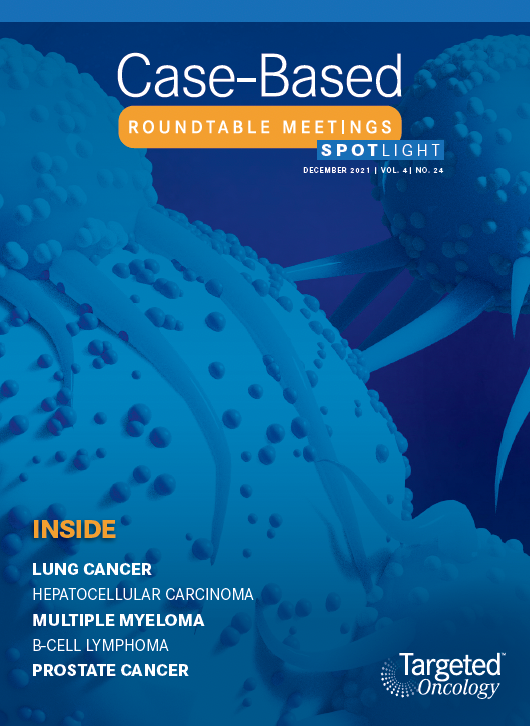
Survivorship Care Promotes Evidence-Based Approaches for Quality of Life and Beyond
March 21st 2025Frank J. Penedo, PhD, explains the challenges of survivorship care for patients with cancer and how he implements programs to support patients’ emotional, physical, and practical needs.
Read More